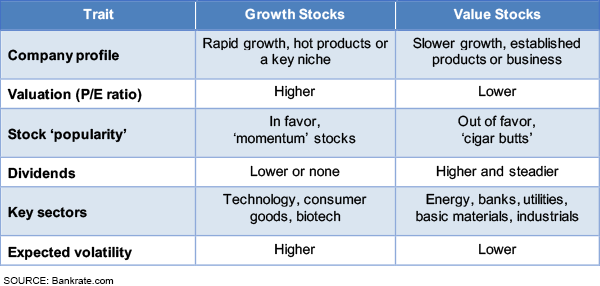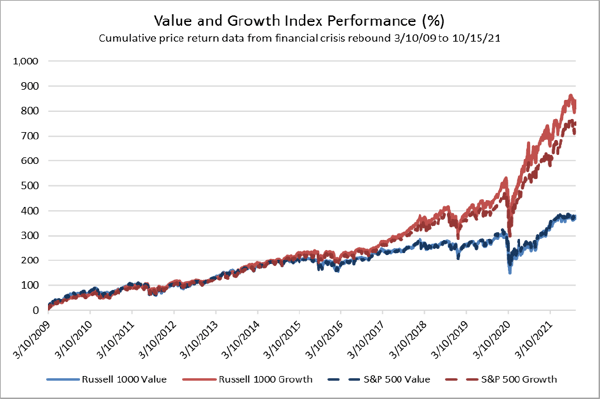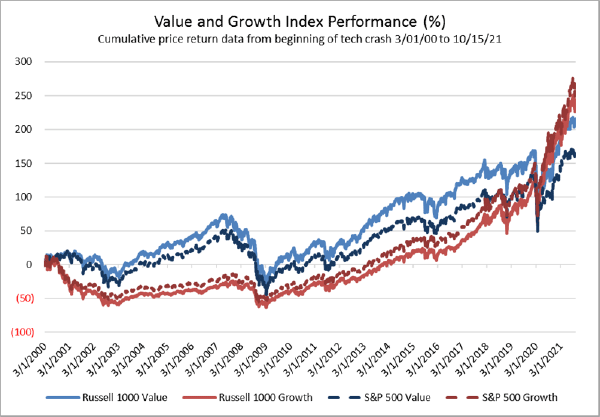A healthy and balanced investment portfolio is a critical part of long-term financial planning. It can grow your wealth over time and help you keep pace with inflation during your retirement years. Of course, this all points to one important question: What’s the best investment strategy? Equity investors often regard growth investing and value investing as the most popular investment styles that share the same end goal—reaping the best possible returns.
One isn’t necessarily better than the other. They’re just two distinct ways to position your investments for potential gains. Your risk tolerance and unique financial situation will likely come into play, but the truth is that there’s room for both strategies in your portfolio.

What Is Growth Investing?
Let’s first talk about what makes these two approaches unique. Those who favor growth investing are interested in stocks that are expected to outperform the overall market because of their future potential. Growth stocks traditionally demonstrate higher revenue, earnings or market-share growth than the market. This may be due to new products, technologies or capturing a growing share of their industry. They are typically characterized by trading at a higher price-to-earnings ratio (P/E) than the market, as investors expect high future growth in profits. These high-growers command a premium in the market compared to value stocks. Growth stocks are generally found in sectors such as information technology, consumer discretionary goods, communication services and health care (biotech stocks).
Growth stocks are also characterized by a higher level of volatility than value stocks and the market as a whole, and may be susceptible to a pullback from a less-than-stellar earnings report, a new competitor or an industry- or company-wide shake-up. This is precisely why relying on growth investing alone could be a risky undertaking. A famous ‘growth’ investor was Thomas Rowe Price Jr., who founded the asset management firm T. Rowe Price.
What Is Value Investing?
Value investors are on the other side of the spectrum. They focus on companies they believe to be undervalued by several metrics, including P/E ratios as well as price-to-cash-flow (P/CF) and price-to-book value (P/B) ratios. Value stocks are prevalent in sectors such as energy, banking and utilities. Revenue and earnings may grow more steadily and predictably, and investors usually receive higher dividends from value stocks compared to growth stocks. Ideally, investors will buy these stocks when they trade at a discount to their future growth, which will be unlocked in the expectation that the market will come to recognize the true value of these “sleeping giant” stocks over time. Of course there’s always the chance that a value stock won’t appreciate as much as an investor hoped for a variety of reasons, which is sometimes referred to as a ‘value trap.’ Benjamin Graham, author of the seminal work The Intelligent Investor, is considered the ‘father’ of value investing.
This table summarizes the broad differences between the two types of styles/stocks:

Which Strategy Is Right for you?
Lots of investors are looking for a magic recipe for success, a just-right blend of different stocks that will lead to the best returns. There’s mixed data out there regarding which investing method is actually superior. While value investing has historically been touted as the best long-term strategy, the last decade has suggested that the scales may be tipping toward growth investing. It’s worth noting, however, that the lion’s share of growth stocks is in the information technology industry, which has evolved tremendously over the last 10 years.
History has taught us that the stock market is quite cyclical. There have been periods where growth stocks have performed better than value stocks, but the opposite has also been true. Growth investing, for example, could be an attractive option when economic growth is high and interest rates are low. Value stocks, on the other hand, tend to attract investors during market pullbacks or when the economy begins to accelerate — but remember, these aren’t guaranteed stock behaviors or results. Here are two graphs showing long-term price returns of two sets of popular value and growth index proxies that illustrate the differences in the two styles:

This data shows the returns of the featured value and growth indices from the first day of the market recovery following the Global Financial Crisis. Value and growth performed equally well until a dynamic change in the technology sector began to cause diverging returns in the middle of the last decade. While value has done well, growth skyrocketed. Investors in either style have still done well.

This data shows the returns of the featured indices from the approximate beginning of the bursting of the Tech Bubble of the 1990s. Value clearly outperformed growth during the ensuing recession and recovery until the Global Financial Crisis of 2008-9. Value also did well as that recovery began, but we can see the gap between the two styles close beginning in the last decade. Long-term, value and growth investors have done well, but volatility has been a constant companion.
These historical graphs demonstrate that trying to time your investments to coincide with market conditions could end up being a losing game. You’ll likely make yourself crazy trying to select the right stocks at the right time. Instead, we encourage investors to leverage both strategies. Some investors prefer an even split, which others feel more comfortable putting more weight on growth or value stocks. Your personal risk tolerance will likely play a role.
Either way, consider it another layer of diversification within your portfolio. An experienced financial advisor can help you fine-tune an asset allocation that’s built on both value and growth stocks. We also assist our clients in periodically rebalancing their portfolios so that their investment plan always remains in line with their long-term financial goals. It’s an important detail since the market may favor growth and value stocks in back-and-forth cycles.
At JJ Burns & Company, we understand that long-term investing has a lot of moving parts. What matters most is maintaining a portfolio that is right for you. We think of ourselves as your partner on that journey, helping to minimize stress so you can enjoy the wealth you’ve worked so hard to build. Schedule a call with us today to start the conversation.




